Changes in PRIMAP-hist v2.6.1_final compared to v2.6_final for Nigeria
2025-03-19
Johannes Gütschow
Change analysis for Nigeria for PRIMAP-hist v2.6.1_final compared to v2.6_final
Overview over emissions by sector and gas
The following figures show the aggregate national total emissions excluding LULUCF AR6GWP100 for the country reported priority scenario. The dotted linesshow the v2.6_final data.
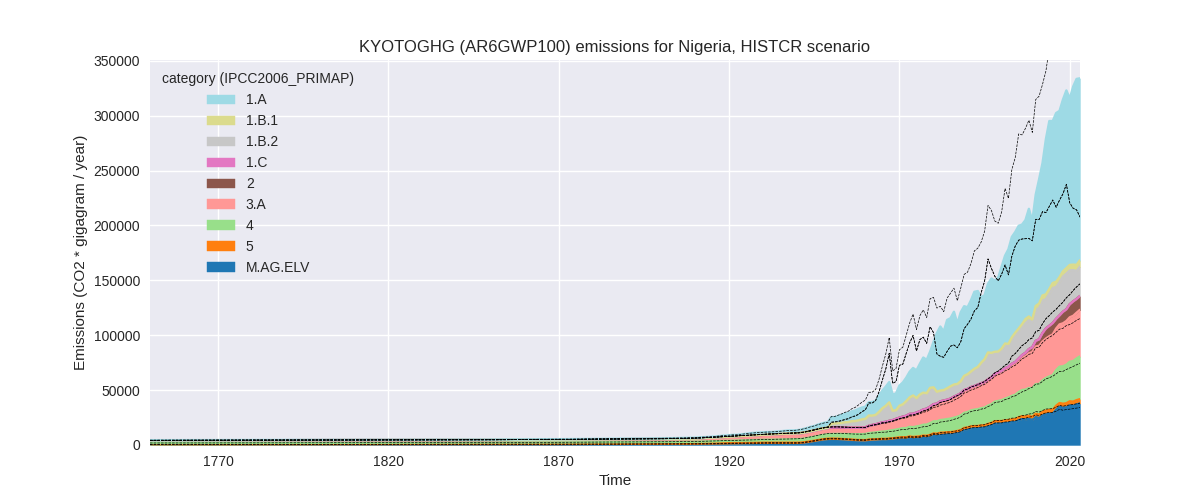
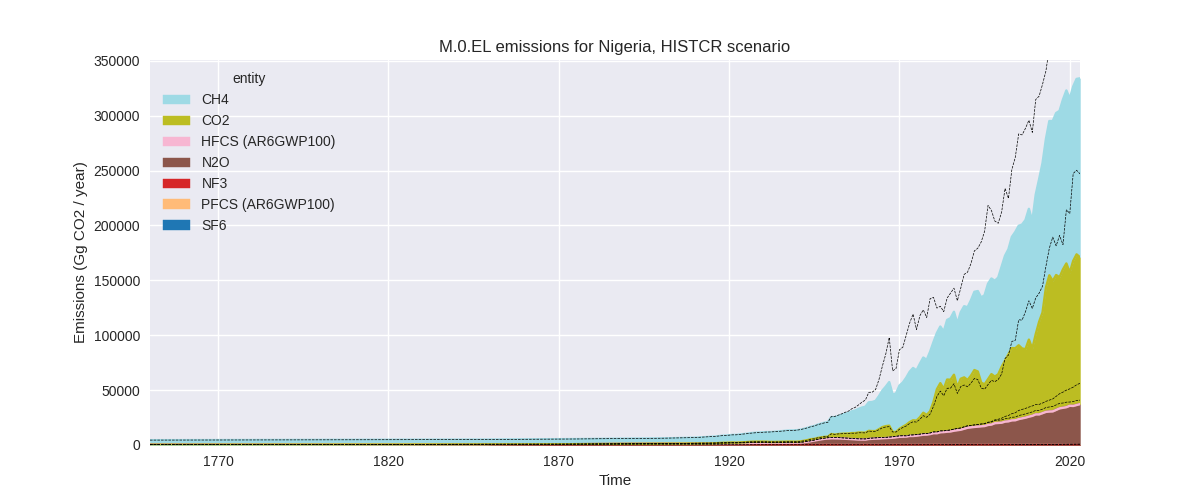
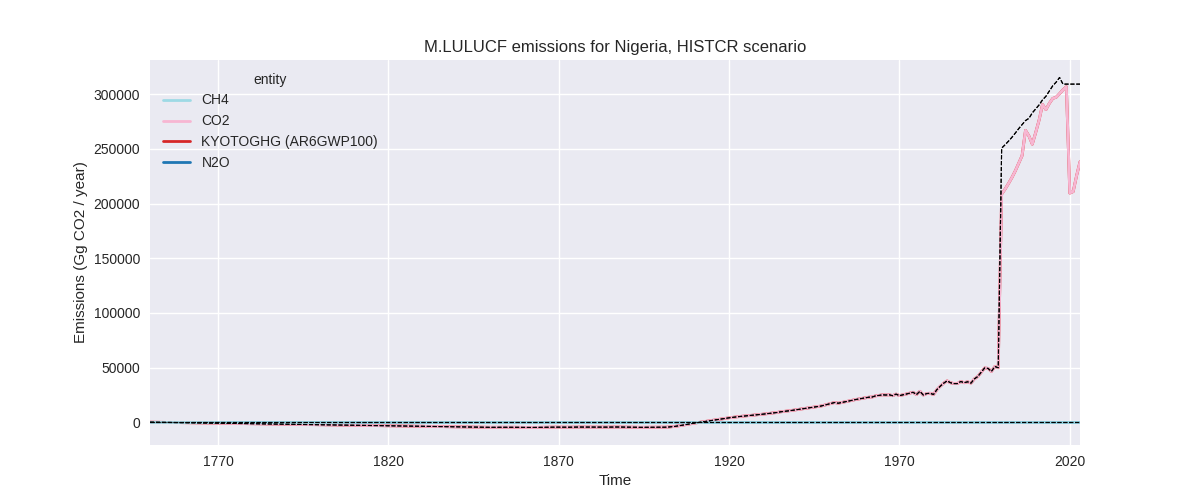
The following figures show the aggregate national total emissions excluding LULUCF AR6GWP100 for the third party priority scenario. The dotted linesshow the v2.6_final data.
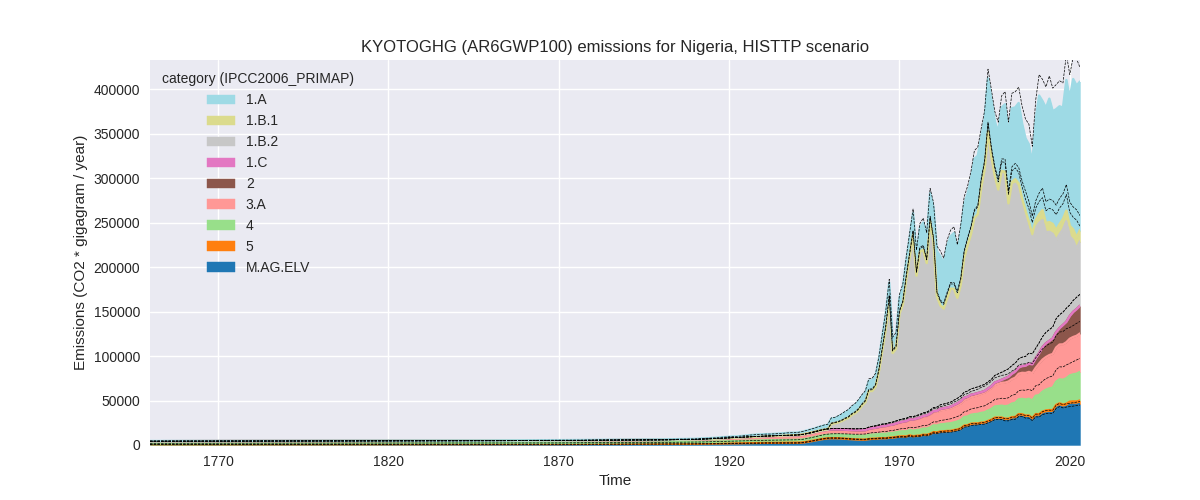
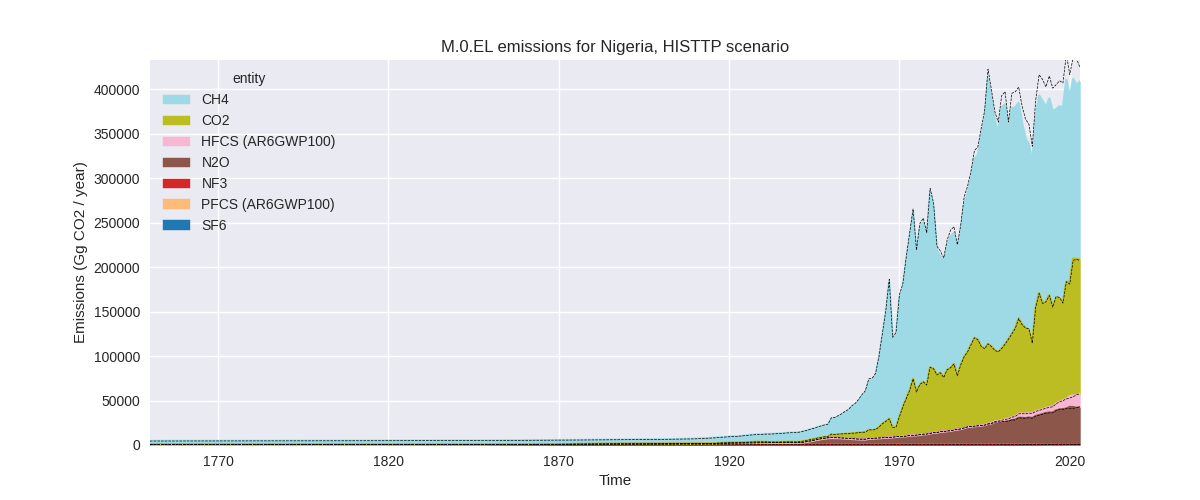

Overview over changes
In the country reported priority scenario we have the following changes for aggregate Kyoto GHG and national total emissions excluding LULUCF (M.0.EL):
- Emissions in 2023 have changed by -17.0%% (-68492.90 Gg CO2 / year)
- Emissions in 1990-2023 have changed by -22.7%% (-64566.16 Gg CO2 / year)
In the third party priority scenario we have the following changes for aggregate Kyoto GHG and national total emissions excluding LULUCF (M.0.EL):
- Emissions in 2023 have changed by -3.7%% (-15768.81 Gg CO2 / year)
- Emissions in 1990-2023 have changed by -4.8%% (-18593.25 Gg CO2 / year)
Most important changes per scenario and time frame
In the country reported priority scenario the following sector-gas combinations have the highest absolute impact on national total KyotoGHG (AR6GWP100) emissions in 2023 (top 5):
- 1: 1.A, CO2 with -50443.22 Gg CO2 / year (-29.7%)
- 2: 1.B.2, CH4 with -30647.22 Gg CO2 / year (-54.1%)
- 3: 1.A, CH4 with 18972.27 Gg CO2 / year (89.1%)
- 4: 2, HFCS (AR6GWP100) with -15335.94 Gg CO2 / year (-100.0%)
- 5: 4, CH4 with 9333.67 Gg CO2 / year (32.1%)
In the country reported priority scenario the following sector-gas combinations have the highest absolute impact on national total KyotoGHG (AR6GWP100) emissions in 1990-2023 (top 5):
- 1: 1.B.2, CH4 with -62819.50 Gg CO2 / year (-73.4%)
- 2: 1.A, CH4 with 9754.64 Gg CO2 / year (51.8%)
- 3: 1.A, CO2 with -8117.03 Gg CO2 / year (-10.1%)
- 4: 4, CH4 with 6286.28 Gg CO2 / year (34.4%)
- 5: 2, HFCS (AR6GWP100) with -4961.30 Gg CO2 / year (-100.0%)
In the third party priority scenario the following sector-gas combinations have the highest absolute impact on national total KyotoGHG (AR6GWP100) emissions in 2023 (top 5):
- 1: 4, CH4 with -16723.57 Gg CO2 / year (-36.1%)
- 2: 1.B.2, CH4 with -3854.05 Gg CO2 / year (-5.9%)
- 3: 3.A, CH4 with 1776.41 Gg CO2 / year (4.4%)
- 4: M.AG.ELV, CH4 with 879.37 Gg CO2 / year (5.8%)
- 5: 1.B.1, CH4 with 711.21 Gg CO2 / year (6.1%)
In the third party priority scenario the following sector-gas combinations have the highest absolute impact on national total KyotoGHG (AR6GWP100) emissions in 1990-2023 (top 5):
- 1: 4, CH4 with -10763.35 Gg CO2 / year (-38.3%)
- 2: 1.B.2, CH4 with -8593.08 Gg CO2 / year (-6.0%)
- 3: 1.B.1, CH4 with 285.01 Gg CO2 / year (4.3%)
- 4: 1.A, CH4 with 212.06 Gg CO2 / year (0.8%)
- 5: 3.A, CH4 with 138.46 Gg CO2 / year (0.5%)
Notes on data changes
Here we list notes explaining important emissions changes for the country.
- CRT data from BTR1 covering 2000-2022 has been included. It replaces
and extends data from BUR2. The highest changes come from the energy
sector and waste emissions.
- HFC emissions are now 0 in the CR scenario as they are included in the country reported data for more than a single year for the first time.
- The most important changes in the TP scenario are from waste and fugitive emissions and come directly from the new EDGAR data.
Changes by sector and gas
For each scenario and time frame the changes are displayed for all individual sectors and all individual gases. In the sector plot we use aggregate Kyoto GHGs in AR6GWP100. In the gas plot we usenational total emissions without LULUCF.
country reported scenario
2023
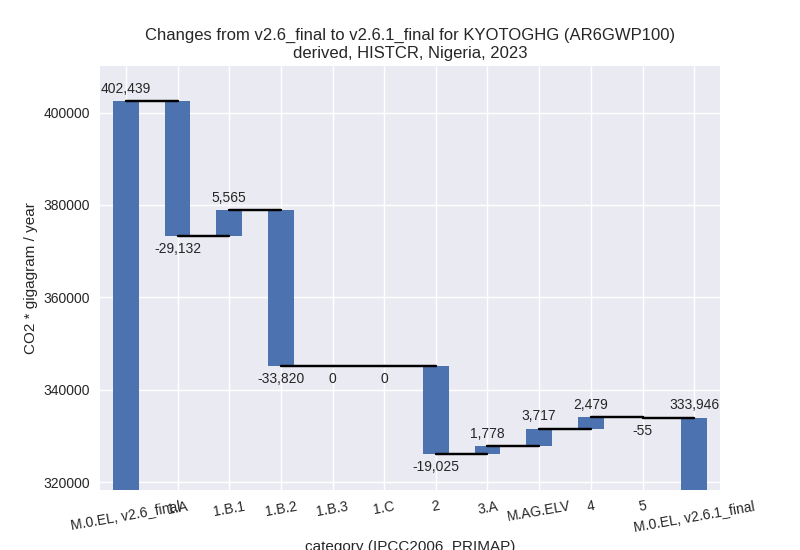
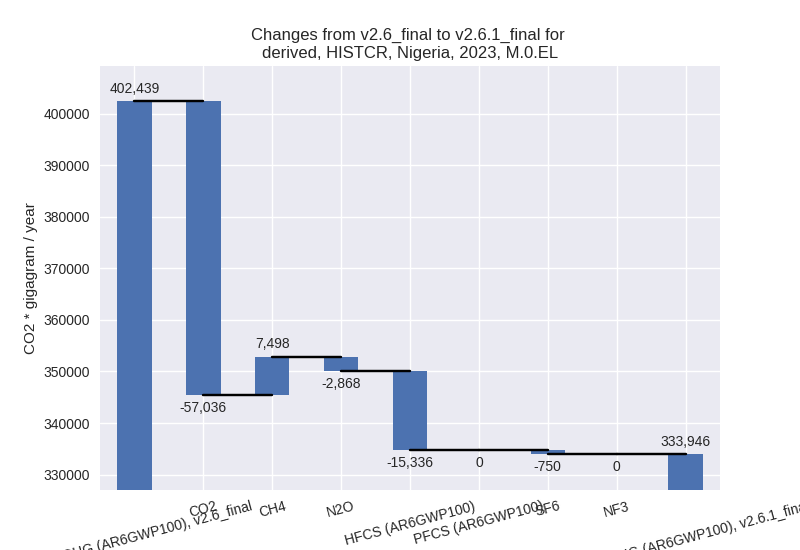
1990-2023
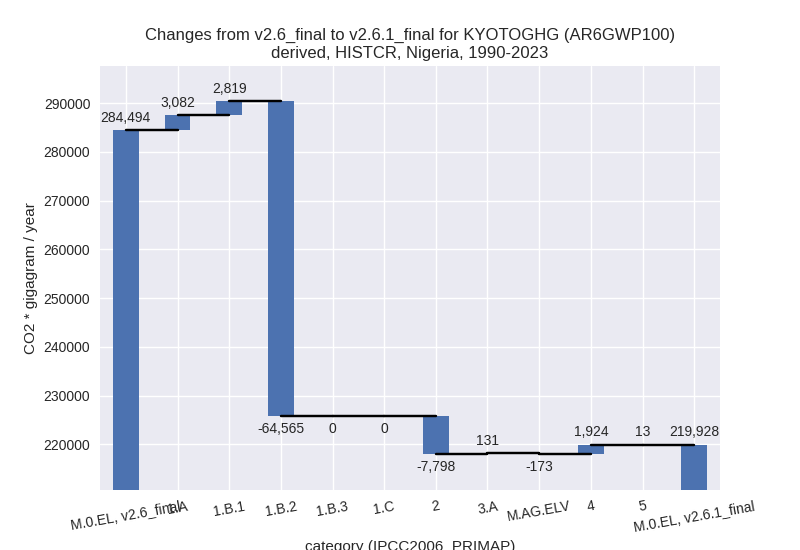
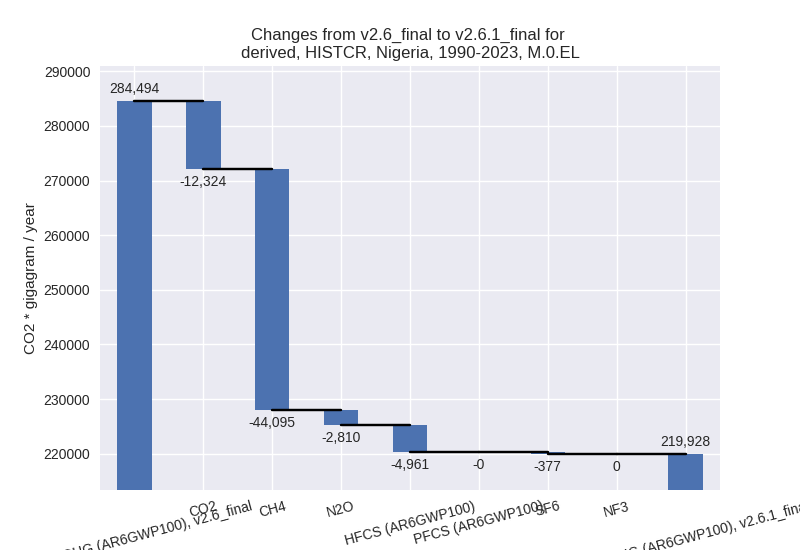
third party scenario
2023
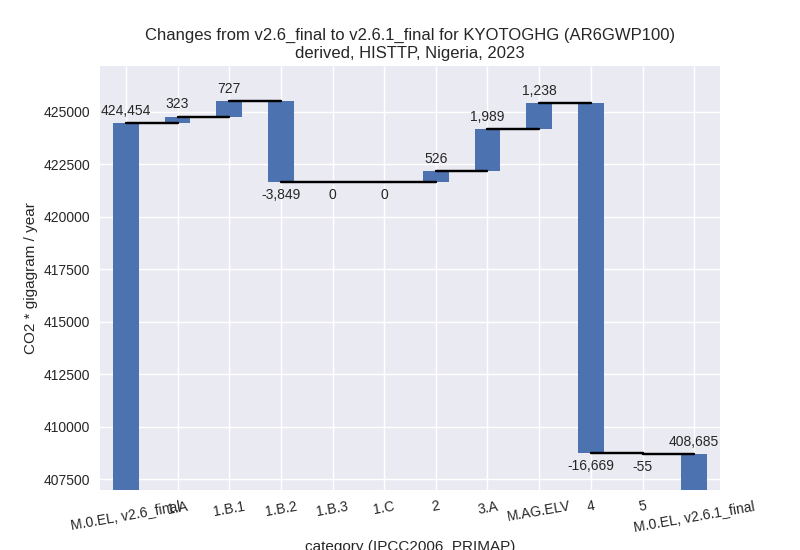
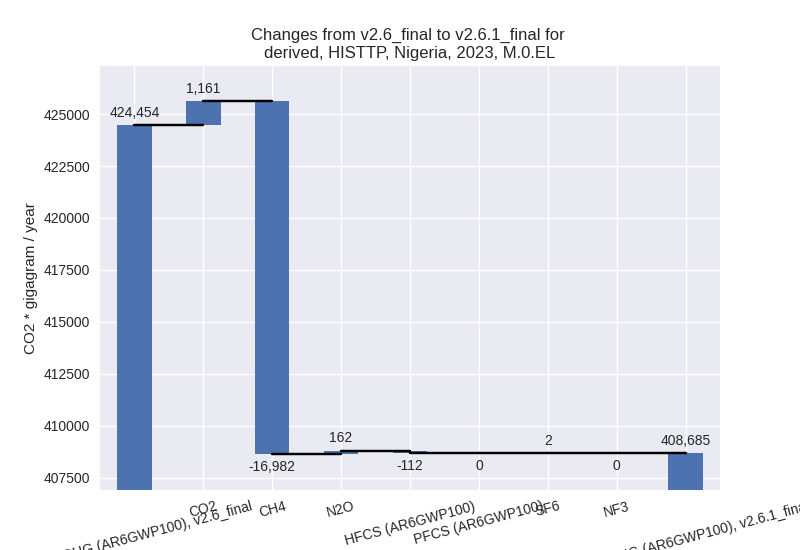
1990-2023
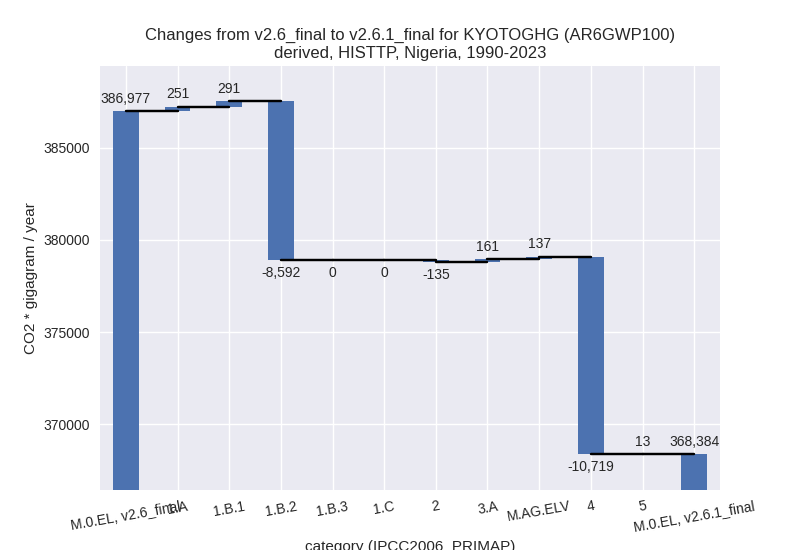
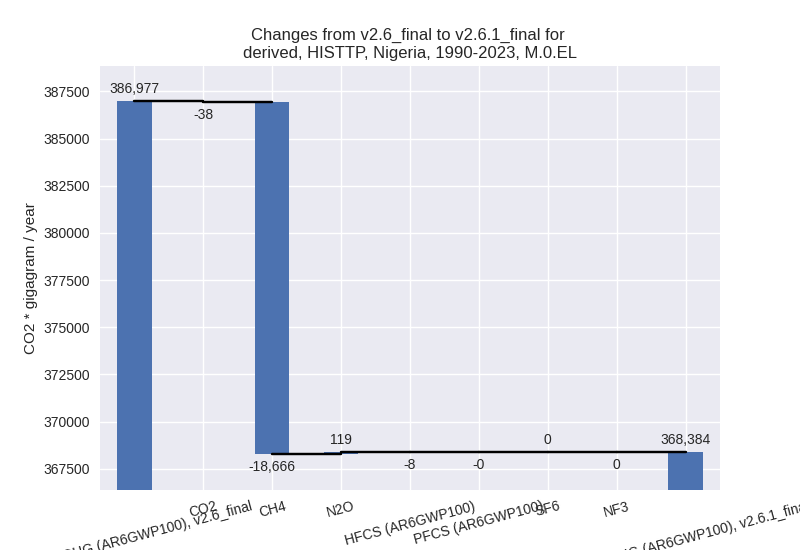
Detailed changes for the scenarios:
country reported scenario (HISTCR):
Most important changes per time frame
For 2023 the following sector-gas combinations have the highest absolute impact on national total KyotoGHG (AR6GWP100) emissions in 2023 (top 5):
- 1: 1.A, CO2 with -50443.22 Gg CO2 / year (-29.7%)
- 2: 1.B.2, CH4 with -30647.22 Gg CO2 / year (-54.1%)
- 3: 1.A, CH4 with 18972.27 Gg CO2 / year (89.1%)
- 4: 2, HFCS (AR6GWP100) with -15335.94 Gg CO2 / year (-100.0%)
- 5: 4, CH4 with 9333.67 Gg CO2 / year (32.1%)
For 1990-2023 the following sector-gas combinations have the highest absolute impact on national total KyotoGHG (AR6GWP100) emissions in 1990-2023 (top 5):
- 1: 1.B.2, CH4 with -62819.50 Gg CO2 / year (-73.4%)
- 2: 1.A, CH4 with 9754.64 Gg CO2 / year (51.8%)
- 3: 1.A, CO2 with -8117.03 Gg CO2 / year (-10.1%)
- 4: 4, CH4 with 6286.28 Gg CO2 / year (34.4%)
- 5: 2, HFCS (AR6GWP100) with -4961.30 Gg CO2 / year (-100.0%)
Changes in the main sectors for aggregate KyotoGHG (AR6GWP100) are
- 1: Total sectoral emissions in 2022 are 200351.36
Gg CO2 / year which is 60.1% of M.0.EL emissions. 2023 Emissions have
changed by -22.4% (-57387.18 Gg CO2
/ year). 1990-2023 Emissions have changed by -30.7% (-58663.07 Gg CO2 / year). For 2023
the changes per gas
are:
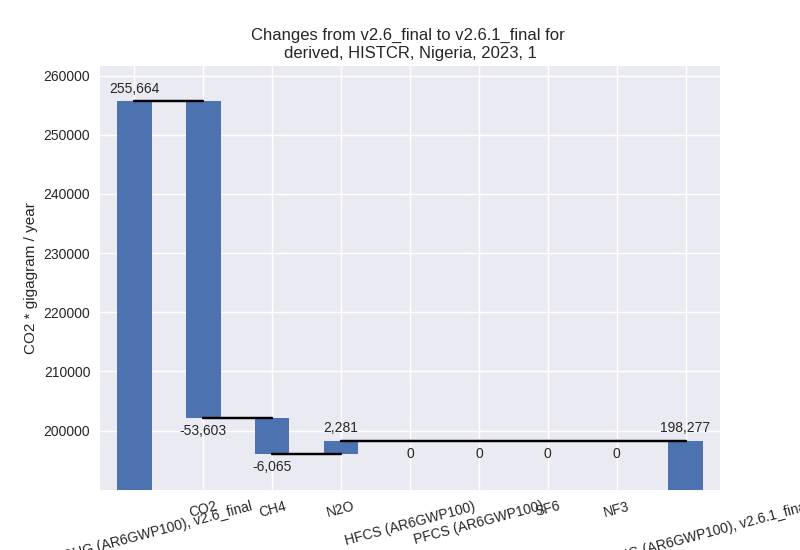
For 1990-2023 the changes per gas are: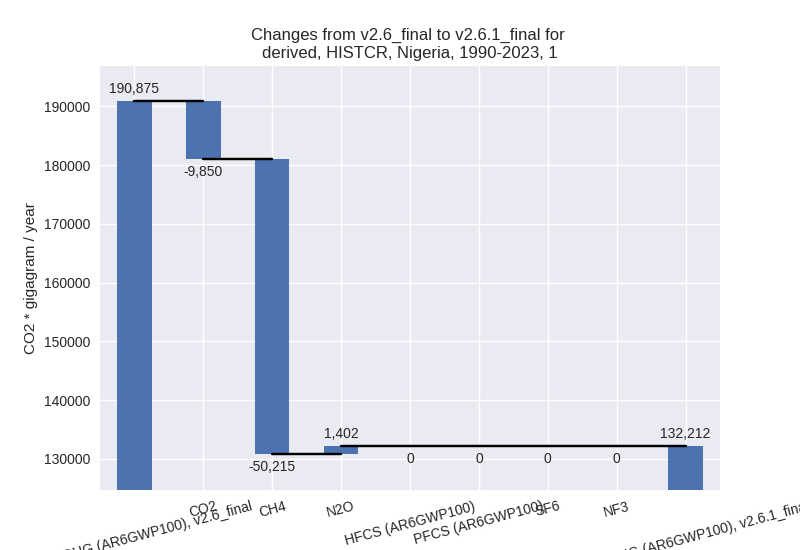
The changes come from the following subsectors:- 1.A: Total sectoral emissions in 2022 are 169360.19
Gg CO2 / year which is 84.5% of category 1 emissions. 2023 Emissions
have changed by -15.0% (-29131.94 Gg
CO2 / year). 1990-2023 Emissions have changed by 3.0% (3082.43 Gg CO2 / year). For 2023 the
changes per gas
are:
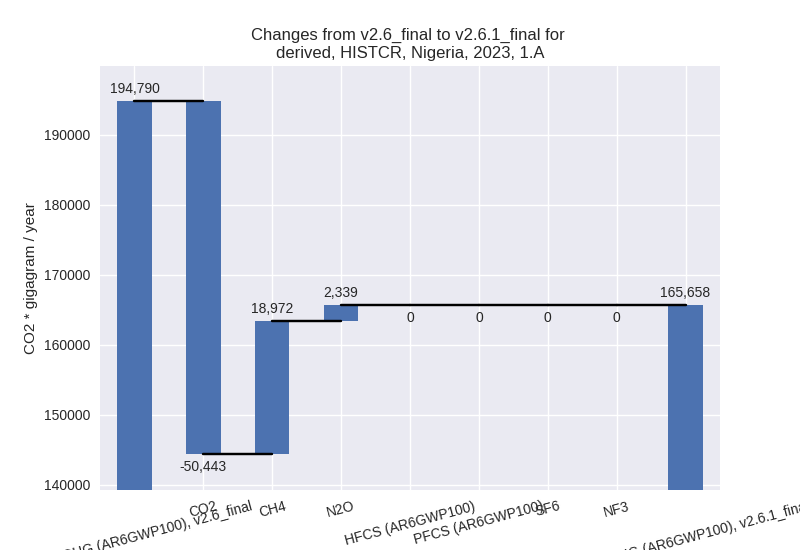
For 1990-2023 the changes per gas are: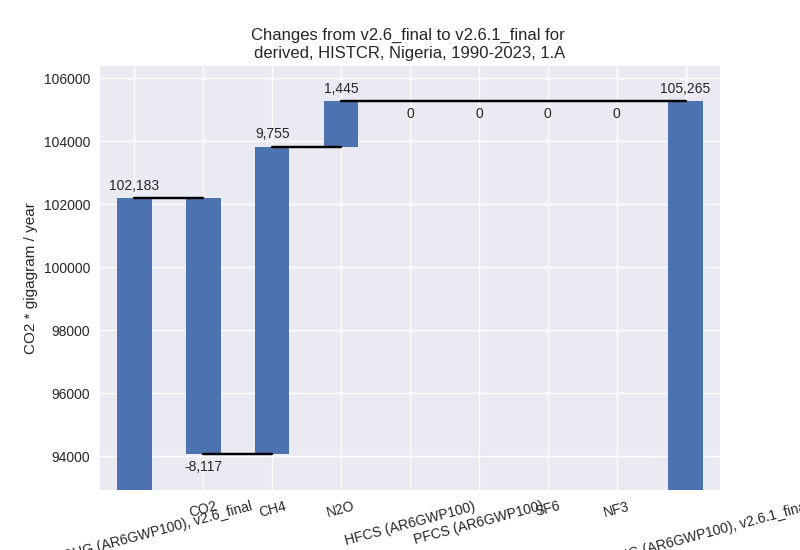
There is no subsector information available in PRIMAP-hist. - 1.B.1: Total sectoral emissions in 2022 are 5727.55
Gg CO2 / year which is 2.9% of category 1 emissions. 2023 Emissions have
changed by 3120.3% (5564.75 Gg CO2 /
year). 1990-2023 Emissions have changed by 2664.0% (2819.19 Gg CO2 / year). For 2023
the changes per gas
are:
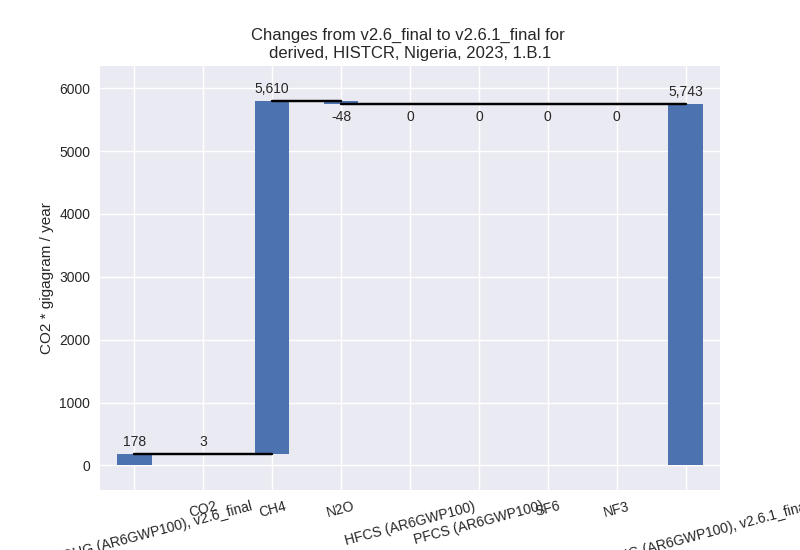
For 1990-2023 the changes per gas are: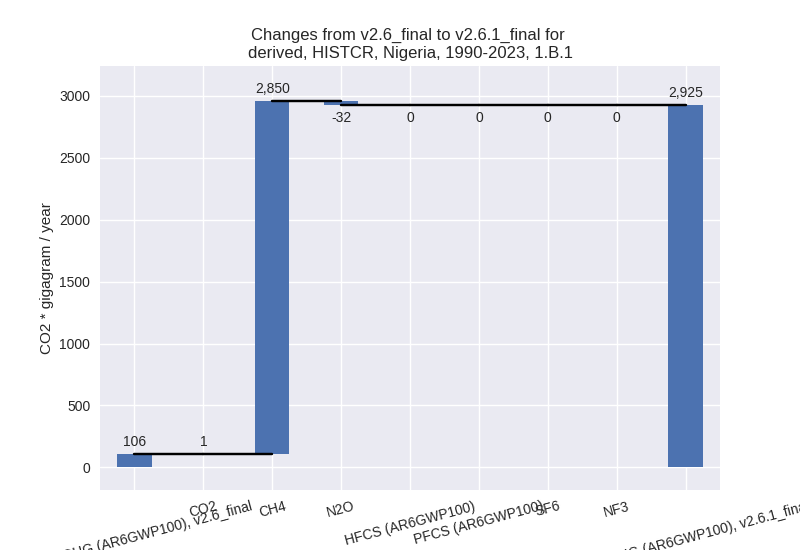
There is no subsector information available in PRIMAP-hist. - 1.B.2: Total sectoral emissions in 2022 are
25263.62 Gg CO2 / year which is 12.6% of category 1 emissions. 2023
Emissions have changed by -55.7%
(-33819.99 Gg CO2 / year). 1990-2023 Emissions have changed by -72.9% (-64564.69 Gg CO2 / year). For 2023
the changes per gas
are:
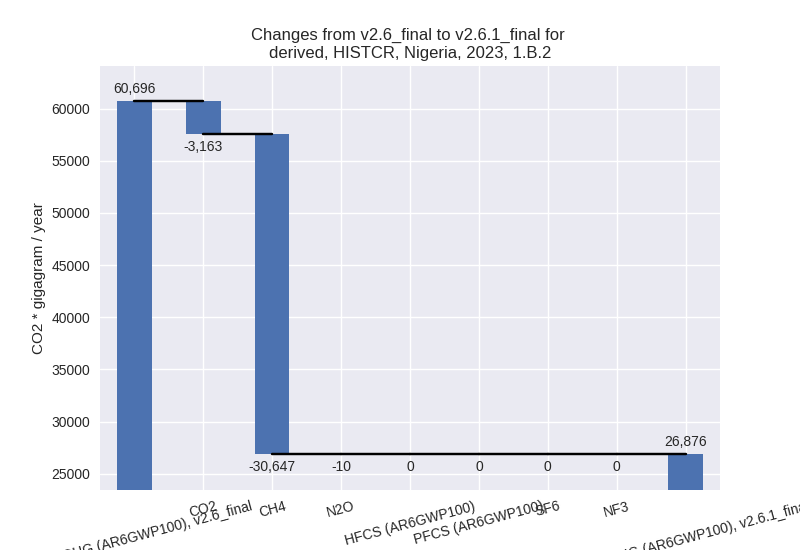
For 1990-2023 the changes per gas are: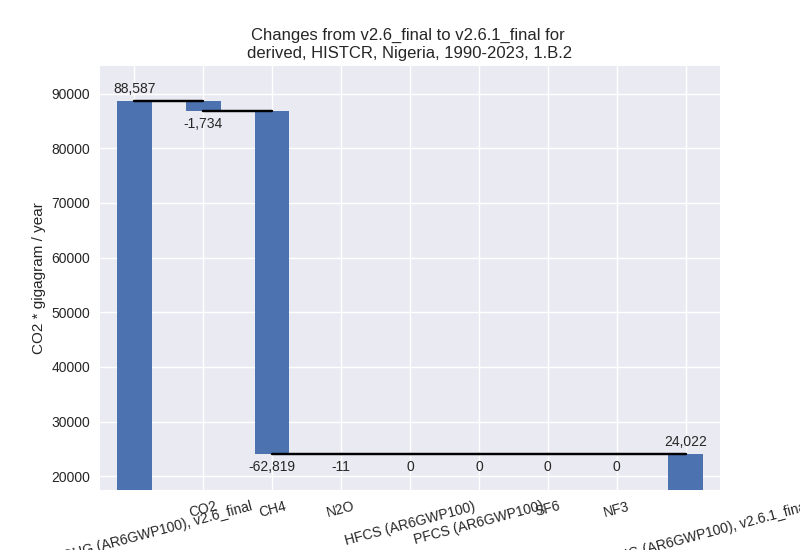
There is no subsector information available in PRIMAP-hist.
- 1.A: Total sectoral emissions in 2022 are 169360.19
Gg CO2 / year which is 84.5% of category 1 emissions. 2023 Emissions
have changed by -15.0% (-29131.94 Gg
CO2 / year). 1990-2023 Emissions have changed by 3.0% (3082.43 Gg CO2 / year). For 2023 the
changes per gas
are:
- 2: Total sectoral emissions in 2022 are 12587.74 Gg
CO2 / year which is 3.8% of M.0.EL emissions. 2023 Emissions have
changed by -60.2% (-19024.72 Gg CO2
/ year). 1990-2023 Emissions have changed by -59.7% (-7798.05 Gg CO2 / year). For 2023
the changes per gas
are:
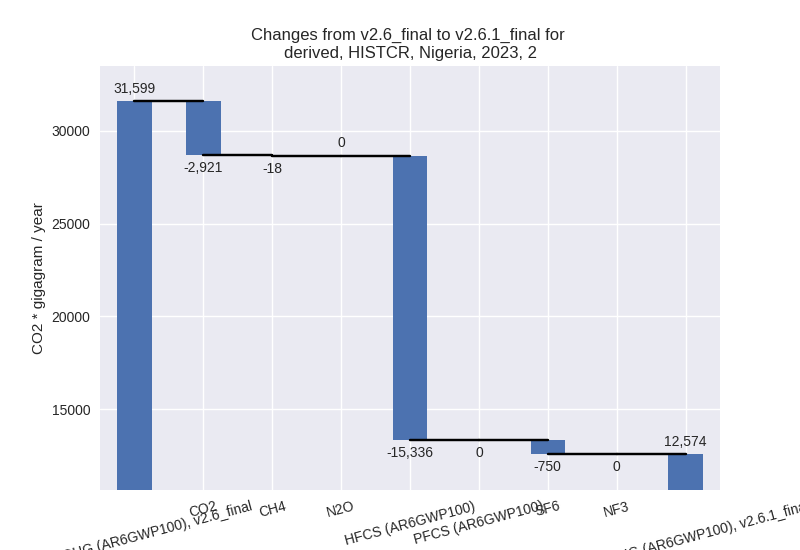
For 1990-2023 the changes per gas are: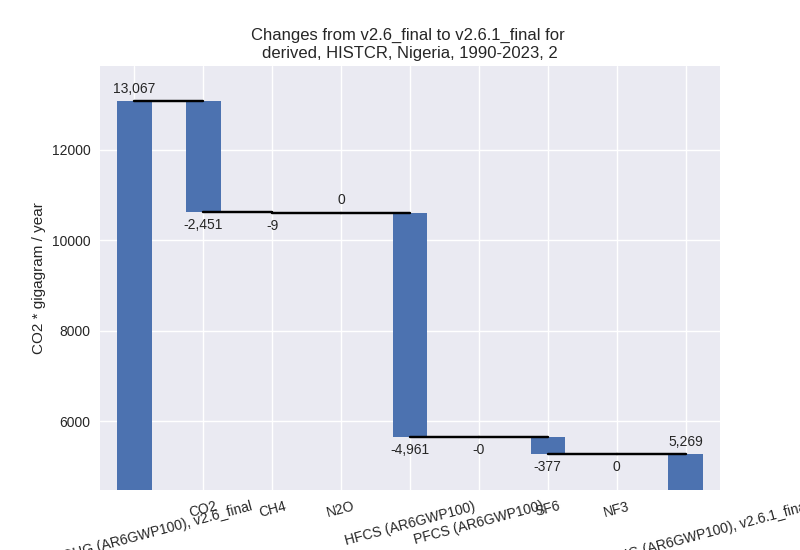
- M.AG: Total sectoral emissions in 2022 are 78552.57
Gg CO2 / year which is 23.6% of M.0.EL emissions. 2023 Emissions have
changed by 7.4% (5494.68 Gg CO2 /
year). 1990-2023 Emissions have changed by -0.1% (-42.05 Gg CO2 / year). For 2023 the
changes per gas
are:
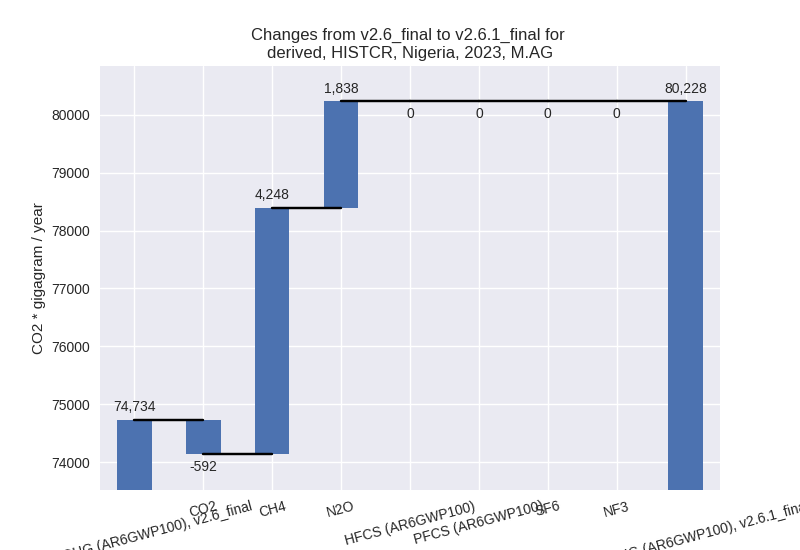
The changes come from the following subsectors:- 3.A: Total sectoral emissions in 2022 are 41701.42
Gg CO2 / year which is 53.1% of category M.AG emissions. 2023 Emissions
have changed by 4.4% (1777.56 Gg CO2
/ year). 1990-2023 Emissions have changed by 0.4% (130.73 Gg CO2 / year). For 2023 the
changes per gas
are:
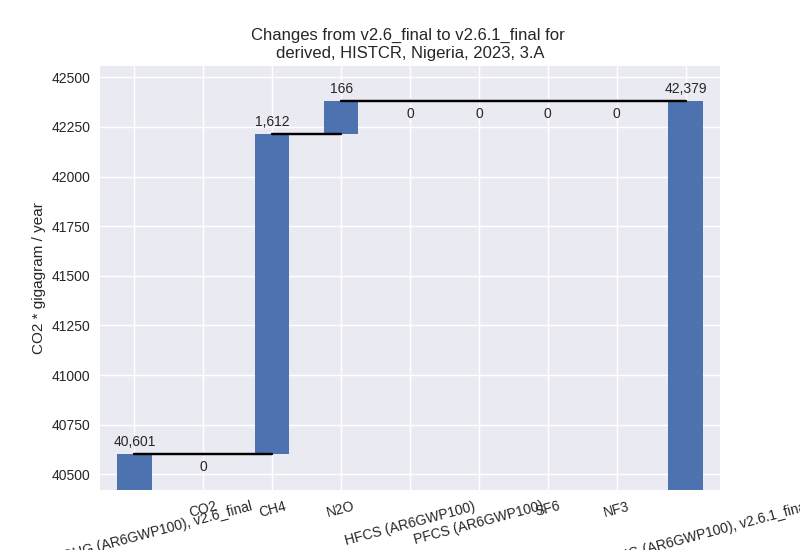
There is no subsector information available in PRIMAP-hist. - M.AG.ELV: Total sectoral emissions in 2022 are
36851.15 Gg CO2 / year which is 46.9% of category M.AG emissions. 2023
Emissions have changed by 10.9%
(3717.13 Gg CO2 / year). 1990-2023 Emissions have changed by -0.7% (-172.78 Gg CO2 / year). For 2023
the changes per gas
are:
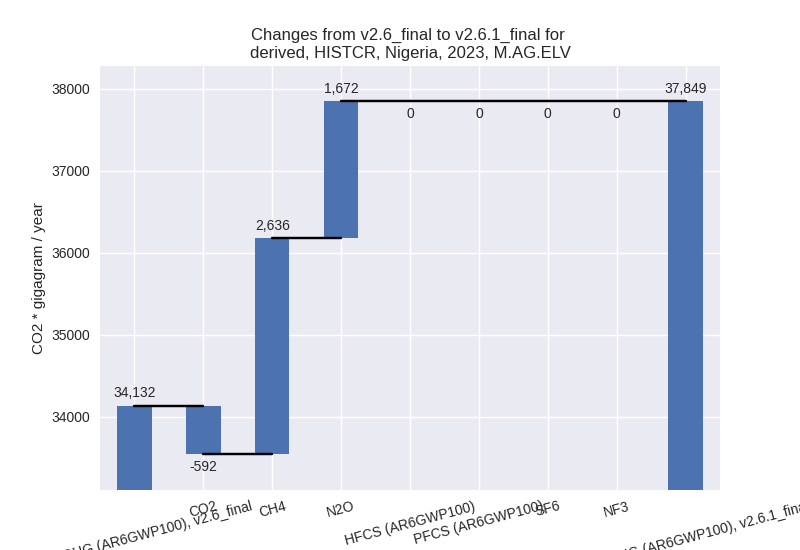
There is no subsector information available in PRIMAP-hist.
- 3.A: Total sectoral emissions in 2022 are 41701.42
Gg CO2 / year which is 53.1% of category M.AG emissions. 2023 Emissions
have changed by 4.4% (1777.56 Gg CO2
/ year). 1990-2023 Emissions have changed by 0.4% (130.73 Gg CO2 / year). For 2023 the
changes per gas
are:
- 4: Total sectoral emissions in 2022 are 37925.08 Gg
CO2 / year which is 11.4% of M.0.EL emissions. 2023 Emissions have
changed by 6.8% (2478.92 Gg CO2 /
year). 1990-2023 Emissions have changed by 8.4% (1924.30 Gg CO2 / year). For 2023 the
changes per gas
are:
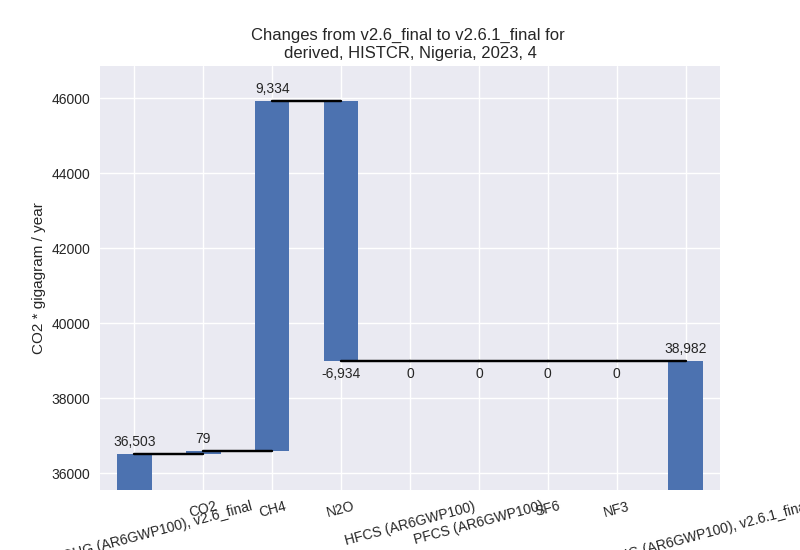
For 1990-2023 the changes per gas are: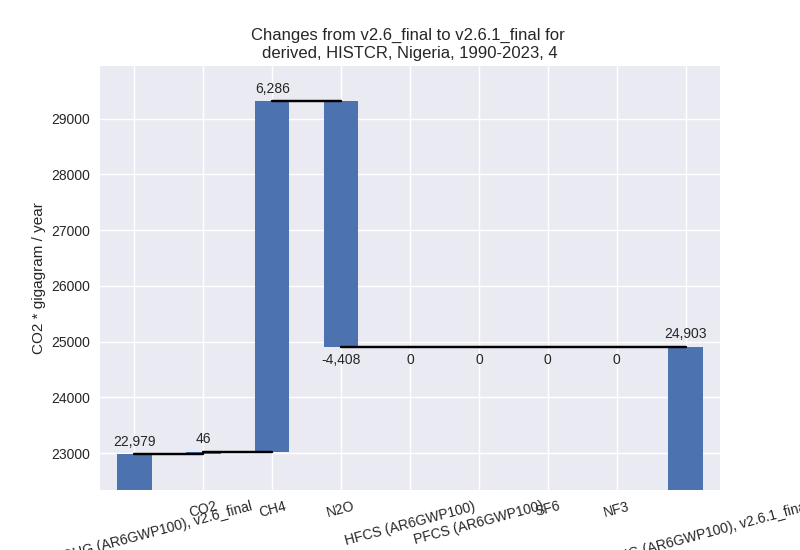
- 5: Total sectoral emissions in 2022 are 3978.98 Gg CO2 / year which is 1.2% of M.0.EL emissions. 2023 Emissions have changed by -1.4% (-54.60 Gg CO2 / year). 1990-2023 Emissions have changed by 0.5% (12.70 Gg CO2 / year).
third party scenario (HISTTP):
Most important changes per time frame
For 2023 the following sector-gas combinations have the highest absolute impact on national total KyotoGHG (AR6GWP100) emissions in 2023 (top 5):
- 1: 4, CH4 with -16723.57 Gg CO2 / year (-36.1%)
- 2: 1.B.2, CH4 with -3854.05 Gg CO2 / year (-5.9%)
- 3: 3.A, CH4 with 1776.41 Gg CO2 / year (4.4%)
- 4: M.AG.ELV, CH4 with 879.37 Gg CO2 / year (5.8%)
- 5: 1.B.1, CH4 with 711.21 Gg CO2 / year (6.1%)
For 1990-2023 the following sector-gas combinations have the highest absolute impact on national total KyotoGHG (AR6GWP100) emissions in 1990-2023 (top 5):
- 1: 4, CH4 with -10763.35 Gg CO2 / year (-38.3%)
- 2: 1.B.2, CH4 with -8593.08 Gg CO2 / year (-6.0%)
- 3: 1.B.1, CH4 with 285.01 Gg CO2 / year (4.3%)
- 4: 1.A, CH4 with 212.06 Gg CO2 / year (0.8%)
- 5: 3.A, CH4 with 138.46 Gg CO2 / year (0.5%)
Changes in the main sectors for aggregate KyotoGHG (AR6GWP100) are
- 1: Total sectoral emissions in 2022 are 251413.50
Gg CO2 / year which is 62.2% of M.0.EL emissions. 2023 Emissions have
changed by -1.1% (-2798.29 Gg CO2 /
year). 1990-2023 Emissions have changed by -2.9% (-8049.72 Gg CO2 / year). For
1990-2023 the changes per gas
are:
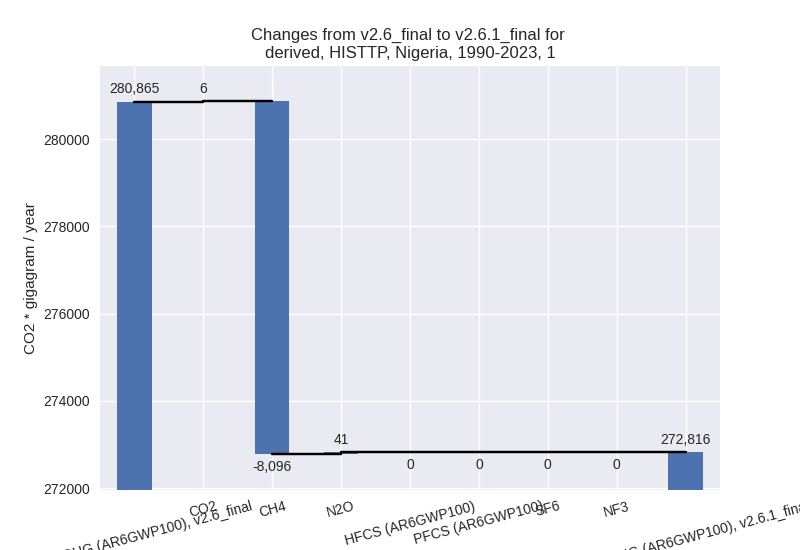
The changes come from the following subsectors:- 1.A: Total sectoral emissions in 2022 are 170693.07 Gg CO2 / year which is 67.9% of category 1 emissions. 2023 Emissions have changed by 0.2% (323.19 Gg CO2 / year). 1990-2023 Emissions have changed by 0.3% (251.31 Gg CO2 / year).
- 1.B.1: Total sectoral emissions in 2022 are
12556.82 Gg CO2 / year which is 5.0% of category 1 emissions. 2023
Emissions have changed by 6.1%
(727.12 Gg CO2 / year). 1990-2023 Emissions have changed by 4.4% (290.83 Gg CO2 / year). For 2023 the
changes per gas
are:
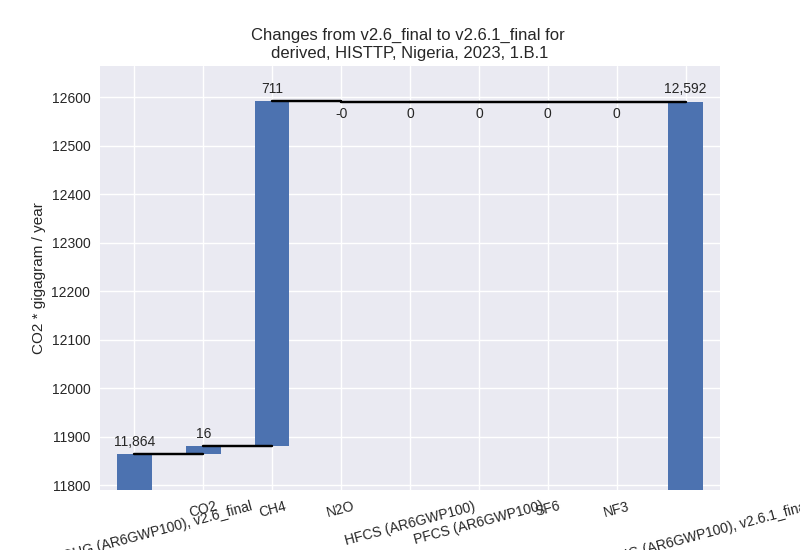
For 1990-2023 the changes per gas are: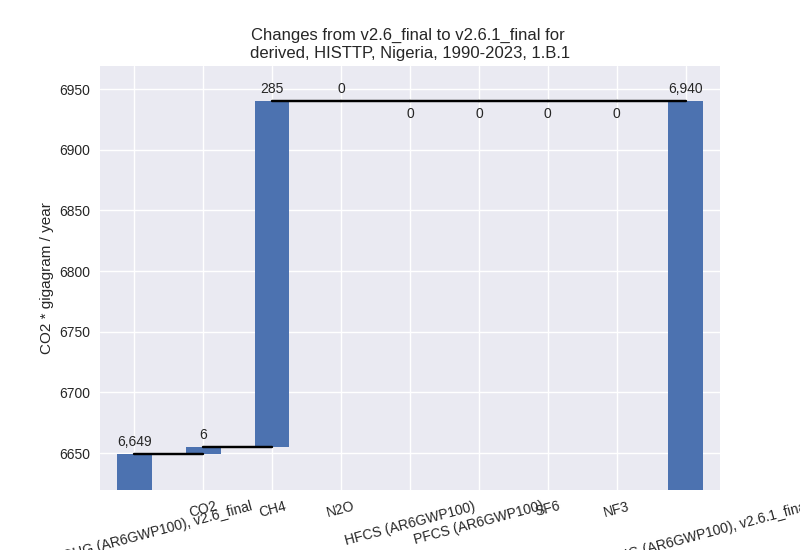
There is no subsector information available in PRIMAP-hist. - 1.B.2: Total sectoral emissions in 2022 are
68163.61 Gg CO2 / year which is 27.1% of category 1 emissions. 2023
Emissions have changed by -5.0%
(-3848.60 Gg CO2 / year). 1990-2023 Emissions have changed by -4.9% (-8591.86 Gg CO2 / year). For 2023
the changes per gas
are:
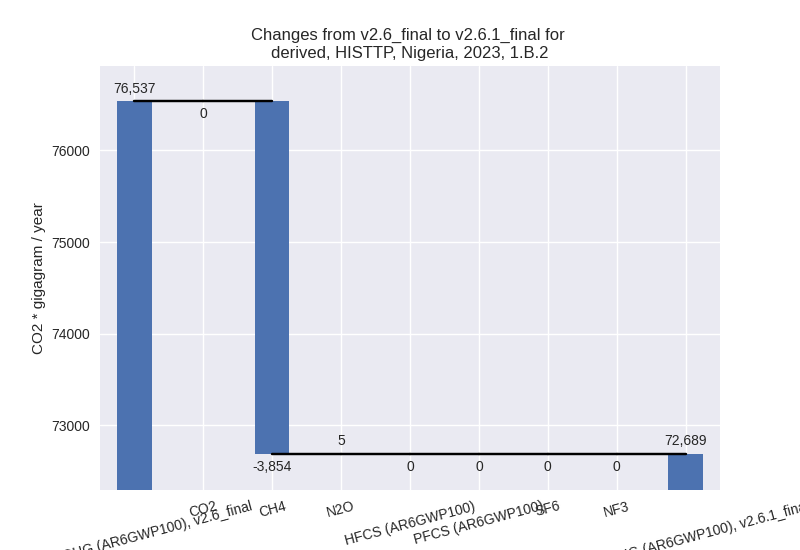
For 1990-2023 the changes per gas are: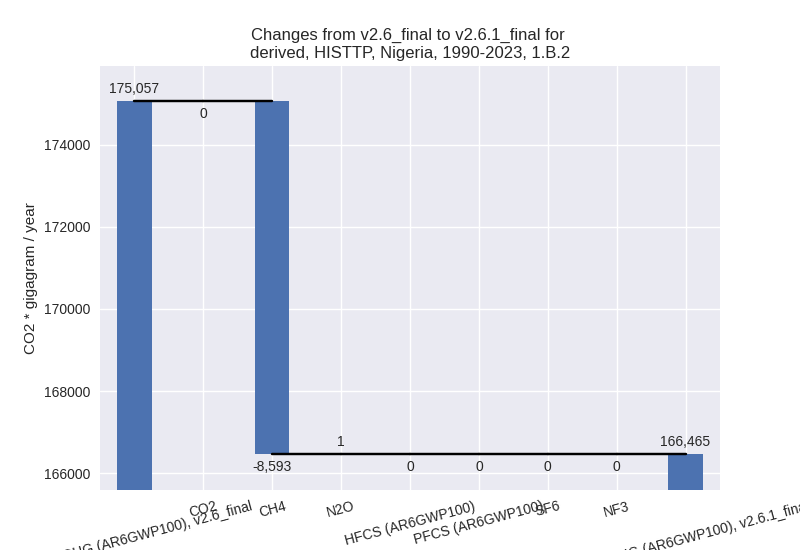
There is no subsector information available in PRIMAP-hist.
- 2: Total sectoral emissions in 2022 are 30007.21 Gg CO2 / year which is 7.4% of M.0.EL emissions. 2023 Emissions have changed by 1.7% (526.15 Gg CO2 / year). 1990-2023 Emissions have changed by -1.2% (-135.24 Gg CO2 / year).
- M.AG: Total sectoral emissions in 2022 are 87531.41
Gg CO2 / year which is 21.7% of M.0.EL emissions. 2023 Emissions have
changed by 3.7% (3227.09 Gg CO2 /
year). 1990-2023 Emissions have changed by 0.5% (298.04 Gg CO2 / year). For 2023 the
changes per gas
are:
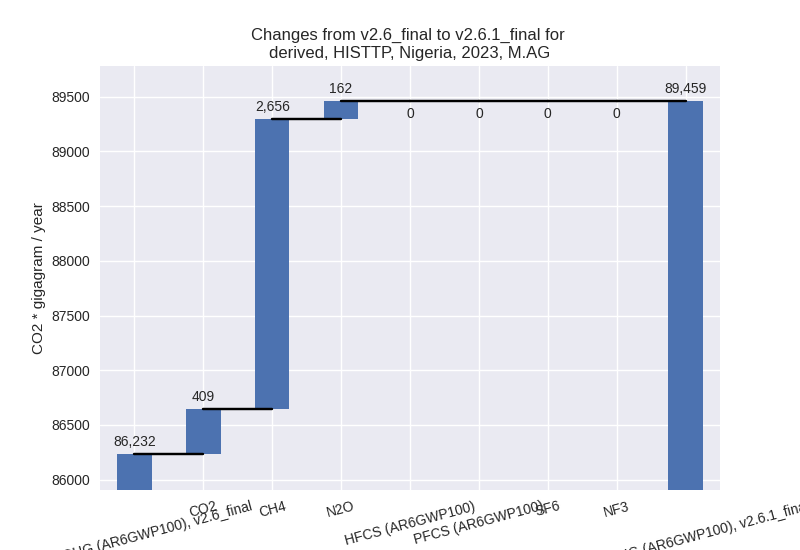
The changes come from the following subsectors:- 3.A: Total sectoral emissions in 2022 are 42620.80
Gg CO2 / year which is 48.7% of category M.AG emissions. 2023 Emissions
have changed by 4.8% (1989.16 Gg CO2
/ year). 1990-2023 Emissions have changed by 0.5% (160.62 Gg CO2 / year). For 2023 the
changes per gas
are:
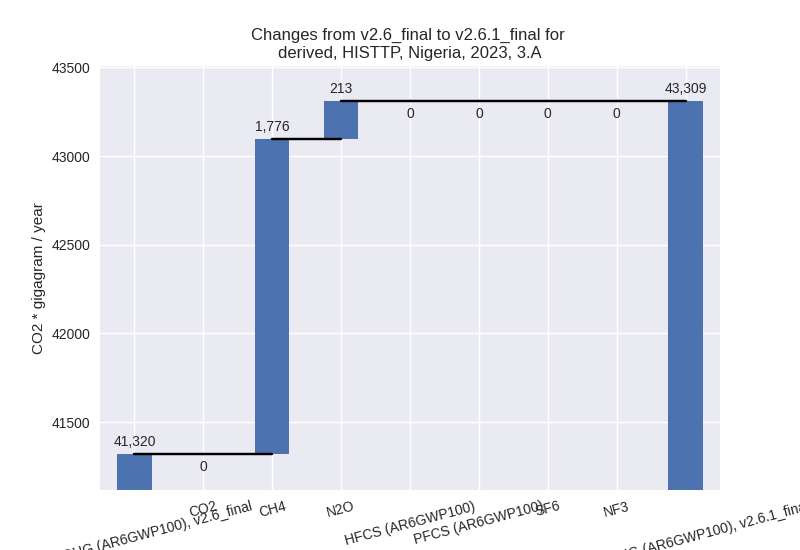
There is no subsector information available in PRIMAP-hist. - M.AG.ELV: Total sectoral emissions in 2022 are
44910.61 Gg CO2 / year which is 51.3% of category M.AG emissions. 2023
Emissions have changed by 2.8%
(1237.93 Gg CO2 / year). 1990-2023 Emissions have changed by 0.4% (137.42 Gg CO2 / year). For 2023 the
changes per gas
are:
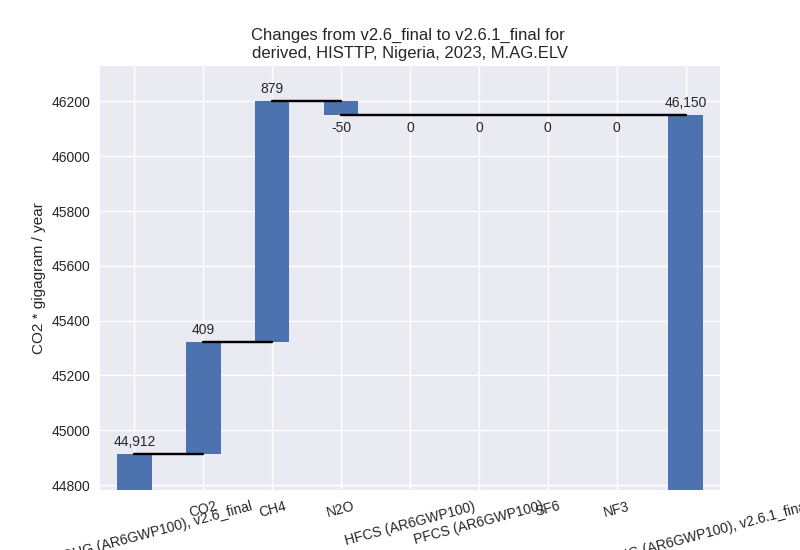
There is no subsector information available in PRIMAP-hist.
- 3.A: Total sectoral emissions in 2022 are 42620.80
Gg CO2 / year which is 48.7% of category M.AG emissions. 2023 Emissions
have changed by 4.8% (1989.16 Gg CO2
/ year). 1990-2023 Emissions have changed by 0.5% (160.62 Gg CO2 / year). For 2023 the
changes per gas
are:
- 4: Total sectoral emissions in 2022 are 31240.87 Gg
CO2 / year which is 7.7% of M.0.EL emissions. 2023 Emissions have
changed by -34.2% (-16669.16 Gg CO2
/ year). 1990-2023 Emissions have changed by -36.0% (-10719.03 Gg CO2 / year). For 2023
the changes per gas
are:
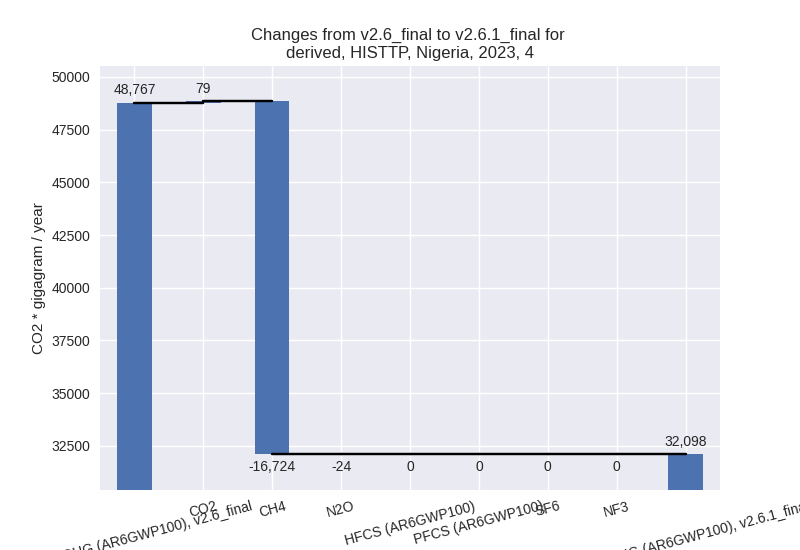
For 1990-2023 the changes per gas are: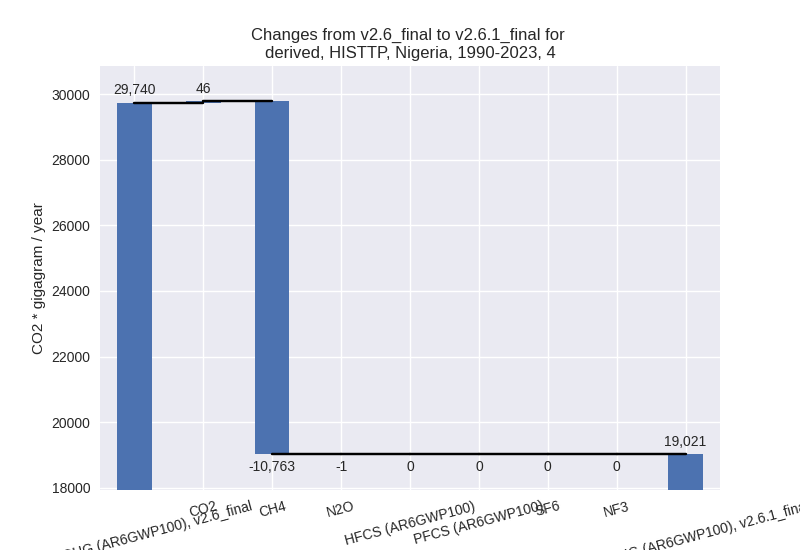
- 5: Total sectoral emissions in 2022 are 3978.98 Gg CO2 / year which is 1.0% of M.0.EL emissions. 2023 Emissions have changed by -1.4% (-54.60 Gg CO2 / year). 1990-2023 Emissions have changed by 0.5% (12.70 Gg CO2 / year).